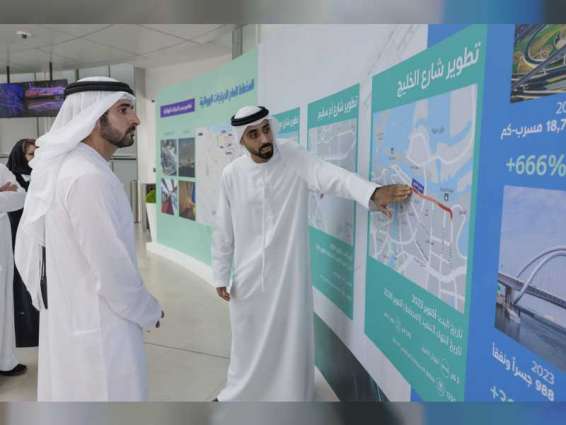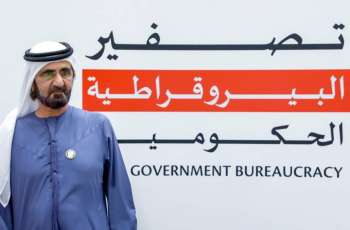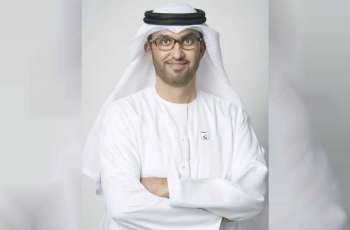DUBAI, (Pakistan Point News - 05th Sep, 2023) H.H. Sheikh Hamdan bin Mohammed bin Rashid Al Maktoum, Crown Prince of Dubai and Chairman of Dubai Executive Council, reviewed the strategic projects and initiatives undertaken by the Roads and Transport Authority (RTA) to develop infrastructure related to road and transport systems in Dubai.
His Highness was also briefed on RTA’s plan to expand the coverage of Intelligent Traffic Systems (ITS), which support the government's drive to transform Dubai into the world's smartest city and promote the use of smart technologies and software to manage traffic and ease mobility around Dubai.
The review took place during His Highness’s visit to the Dubai ITS Centre in Al Barsha, a subsidiary of the RTA. One of the largest and most advanced traffic control centres in the world, the centre boosts Dubai’s ability to meet its growing needs emerging from its increasing urbanisation. It also raises its global standing in intelligent traffic systems, ranking it among cities such as Singapore and Seoul.
Upon arrival at the Dubai ITS Centre, His Highness was received by Mattar Al Tayer, Director-General and Chairman of the board of Executive Directors of the Roads and Transport Authority, and several senior RTA officials.
At the start of the visit, His Highness received a briefing from Mattar Al Tayer, about the Dubai ITS Centre, which was developed under the directives of His Highness Sheikh Mohammed bin Rashid Al Maktoum, Vice President, Prime Minister and Ruler of Dubai.
The centre uses cutting-edge technologies including Artificial Intelligence, Big Data, the internet of Things (IoT), and advanced communication systems to provide innovative traffic solutions.
Equipped with an array of traffic-monitoring and data-gathering devices, as well as a suite of smart services, the centre plays a key role in ensuring that Dubai's intelligent traffic management systems are able to effectively manage the rapid expansion of the city’s current and future road networks.
Since its opening in November 2020, the Dubai ITS Centre has significantly enhanced the city's traffic management, leading to a 20 percent reduction in travel time, a 63 percent improvement in incident monitoring and a 30 percent faster response time.
“The centre currently monitors 60 percent of the main road network in Dubai, and RTA aims to increase coverage to 100 percent in 2026. Traffic signals and the traffic control system are now 100 percent interlinked.
“The centre features an advanced traffic control system (iTraffic) enhanced with Artificial Intelligence as well as big data analysis and decision-making support tools to facilitate the management of traffic movement. Linking all of Dubai, the system ensures a smooth traffic flow, manages incidents, emergencies and events, monitors the efficiency of operational systems and reports malfunctions. The centre is connected to an 820-km-long fibre optic network, and 425 traffic surveillance cameras, including Dubai police cameras. It is also equipped with 235 incident-monitoring and vehicle counting devices, 115 travel time measurement devices, 112 electronic display signs, and 17 road weather information systems,” Al Tayer said.
His Highness was briefed on the smart screening system for paid public parking, which currently covers 65,000 slots or 34 percent of all paid parking. These are monitored by nine smart screening vehicles, which are set to double to 18 by the end of the year. The expansion will cover around 140,000 slots or 70 percent of total paid parking. The system has significantly enhanced the operational efficiency and digital transformation of the parking screening process.
His Highness was briefed on mega road projects implemented by RTA in the previous phase: the Dubai-Al Ain Road Improvement Project, the Infinity Bridge developed under the Al Shindagha Corridor Improvement Project, and the Sheikh Rashid bin Saeed Corridor Improvement Project.
RTA seeks to develop several main roads in the next phase, including a project to develop Hessa Street from its intersection with Sheikh Zayed Road to its intersection with Al Khail Road stretching 4.5 km to augment its capacity to 16,000 vehicles per hour. It also entails the Umm Suqeim Street Improvement Project from its intersection with Al Khail Road to its intersection with Sheikh Mohammed bin Zayed Road extending 4.6 km, increasing its capacity to 16,000 vehicles per hour, and the Al Khaleej Street Improvement Project, stretching 3 km from the Infinity Bridge ramp to Cairo Street. The project encompasses the construction of three underpasses stretching 1.65 km, with an estimated capacity of about 12,000 vehicles per hour.
His Highness was also apprised of major indicators of the rapid development of Dubai’s road network infrastructure. The total length of Dubai’s road network has grown from 8,715 lane-km in 2006 to 18,768 lane-km in 2022, marking a 115 percent growth. The number of bridges and underpasses saw a big increase, from 129 to 988 during the same period, a 666 percent expansion. Moreover, the number of pedestrian bridges and underpasses increased from 26 in 2006 to 122 in 2022, an increase of 369 percent.
Efforts to ramp up traffic safety standards have contributed to a significant drop in incident-related fatalities, from approximately 22 cases per 100,000 of the population in 2006 to only 1.9 cases in 2022, placing Dubai among the best global cities in terms of traffic safety alongside urban centres in Sweden, Norway, and Japan. These improvements have put the UAE in the global top tier in road quality between 2013 and 2017 and secured it a high international ranking in the road and highways satisfaction index in 2020.
His Highness also reviewed the master plan to expand the construction of cycling tracks until 2026. The cycling track network in Dubai is set to expand from 544 km in 2023 to 819 km by 2026.
His Highness also took a closer look at the upcoming cycling track as part of the Hessa Street Improvement Project. This 13.5 km long track, with a width of 5.5 metres, will feature a dedicated track width of 2.5 metres for bikes and scooters and 2 metres for pedestrians. It links Al Sufouh and Jumeirah to Dubai Hills via Hessa Street, serving residential communities like Al Barsha and Barsha Heights. Furthermore, it contributes to enhancing first and last-mile trips, linking with the Dubai Internet City Metro Station and nearby commercial areas. This track is distinguished by two specially designed bridges: one over Sheikh Zayed Road and another over Al Khail Road. Both bridges are five metres wide, with tracks for e-scooters and cyclists three metres across and those for pedestrians two metres across.
His Highness was apprised of the outcomes of the RTA Path to 2040 workshop, which saw the participation of 11 international consultants. The workshop aimed to propose solutions to address traffic congestion on Al Khail, Jumeirah and Al Wasl roads. A multitude of engineering and traffic concepts and solutions were put forward, encompassing public transport, mobility policies and soft mobility. Among the key solutions presented were the transformation of sections of Jumeirah Road into an urban boulevard and the expansion of Al Wasl Road to accommodate three lanes in each direction.
His Highness was also briefed on the key outcomes of the 2022 traffic index report by TomTom, which is a global company specialising in monitoring congestion and traffic worldwide and provides its analyses to 390 cities across 56 countries.
In a recent evaluation, Dubai surpassed major global cities like Los Angeles, Montreal, Sydney, Berlin, Rome and Milan in average time needed to travel 10 km in the central business district (CBD). Dubai clocked in at 12 minutes, compared to the referenced cities' average of 21 minutes. The top performer, Almere in the Netherlands, averaged 8 minutes, while the lowest-performing city was London with 36 minutes.
His Highness toured the facilities of the Dubai Intelligent Traffic Systems Centre, which boasts world-class design and equipment, such as mega screens, and user-friendly control systems for operators and engineers of the intelligent traffic systems.
The facility also includes a specialised centre for managing and monitoring traffic movement, equipped with giant display monitors as well as specialist rooms with the latest in technology to deal with emergency traffic movements. It also has offices for engineering teams tasked with the management and improvement of systems and the provision of backup support.




